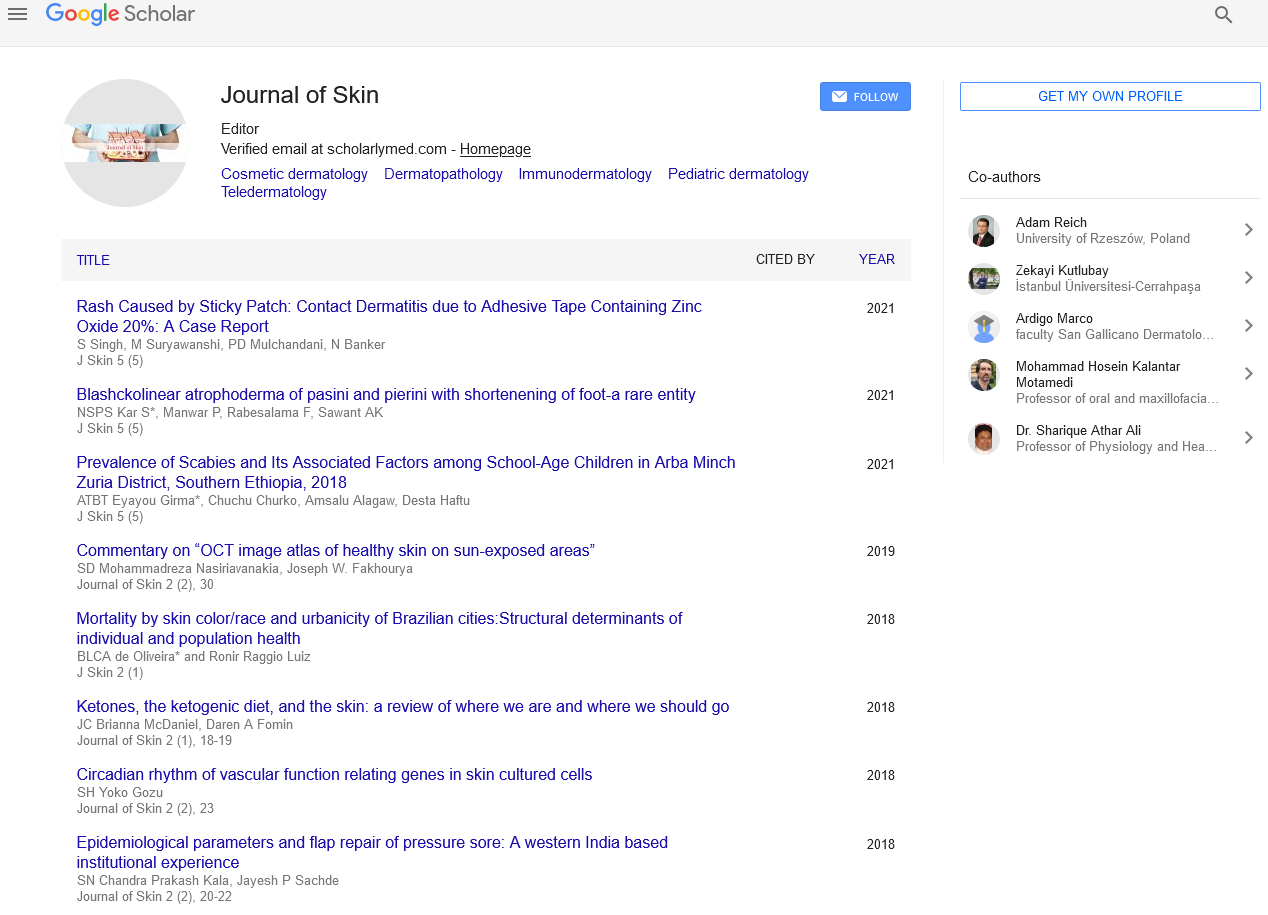Role of immune system and genetics in psoriasis
Received: 03-Sep-2021 Accepted Date: Sep 17, 2021; Published: 24-Sep-2021
Citation: Malcom D. Role of immune system and genetics in psoriasis. J Skin. 2021;5(4):2
This open-access article is distributed under the terms of the Creative Commons Attribution Non-Commercial License (CC BY-NC) (http://creativecommons.org/licenses/by-nc/4.0/), which permits reuse, distribution and reproduction of the article, provided that the original work is properly cited and the reuse is restricted to noncommercial purposes. For commercial reuse, contact reprints@pulsus.com
Description
Psoriasis is an associate degree immune-mediated illness (an illness with an associate degree unclear cause that's characterized by inflammation caused by pathology of the immune system) that causes inflammationwithin the body. There could also be visible signs of inflammation like raised plaques (plaques could look different for various skin types) and scales on the skin. This occurs as a result of the active system races somatic cell growth. Traditional skin cells fully grow and shed (fall off) during a month. With skin conditions, skin cells try this in three or four days. Rather than shedding, the skin cells collect on the surface of the skin. Some folks report that skin condition plaques itch, burn, and sting. Plaques and scales could seem on any part of the body, though they're normally found on the elbows, knees, and scalp.
Symptoms and Treatment
Symptoms typically begin between ages fifteen and twenty-five however will begin at any age. Men, women, and youngsters of all skin colors will get skin conditions.
There are five forms of skin condition. It’s potential to possess over one style of skin condition on just one occasion and over one sort during a period.
• Plaque skin condition: Plaque skin condition is that the most typical style of psoriasis.
• Guttate skin condition: Guttate psoriasis is common in childhood. This sort of skin condition causes little pink spots.
• Pustular skin condition: Pustular psoriasis is a lot common in adults. It causes white, pus-filled blisters and broad areas of red, inflamed skin.
• Inverse skin condition: Inverse psoriasis causes bright areas of red, shiny, inflamed skin.
• Erythrodermic skin condition: Erythrodermic skin condition may be a severe and really rare style of psoriasis. This sort is often severe, therefore people ought to see a doctor directly.
The most common symptoms of Plaque skin condition include Raised, inflamed patches of skin; whitish-silver scales or plaques on the red patches or grey scales on purple and brown patches; dry skin which will crack and bleed; soreness around patches; haptic sensation and burning sensations around patches; thick, cavitied nails and painful, swollen joints.
Psoriasis will seem anyplace on the body, even on the eyelids, ears, lips, skin folds, hands, feet, and nails. Plaques are often many little patches or will affect massive areas.
There are two key factors for the reason for this disease: genetics and the immune system.
Immune system: Psoriasis is an associate degree response condition. Response conditions area unit the results of the body assaultive itself. Within the case of skin condition, white blood cells referred to as T cells erroneously attack the skin cells.
In a typical body, white blood cells are unit deployed to attack and destroy invasive bacterium and fight infections. This mistaken attack causes the somatic cell production method to travel into overdrive. The sped-up somatic cell production causes new skin cells to develop too quickly. They’re pushed to the skin’s surface, wherever they collect.
Genetics: Some folks inherit genes that build them a lot of possibilities to develop the skin condition. If you have got an instantaneous friend with a skin condition, your risk for developing a skin condition is higher. However, the share of individuals WHO have a skin condition and a genetic predisposition is little. Two tests or examinations could also be necessary to diagnose skin condition: Physical examination and diagnostic test.
The most common triggers for skin conditions include Stress, Alcohol, and Injuries and Medications.
Some medications area unit thought of skin condition triggers. These medications include Lithium, antimalarial medications, and high-pressure level medication.
Many topical, oral, and injected medications are unit out there for folks with a skin condition: Coal tar, Hydrocortisone creams, Salicylic acid, Antiitch agents, Topical therapies, Corticosteroids, Synthetic calciferol, Retinoid, Pimecrolimus cream, and tacrolimus ointment, Systemic therapies, Off-label medications, Phototherapy, Home remedies, etc.
Conclusion
The root reason for the skin condition is unclear. However, several environmental triggers, as well as stress and secretion changes, will cause symptom flares. Although there's no definitive cure for the condition, recent developments in skin condition treatments mean that individuals will cut back the number of flares they expertise in and their severity. Treatments for delicate cases of skin condition embrace topical ointments and way changes.





